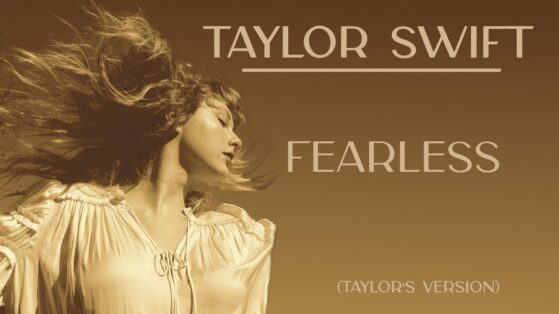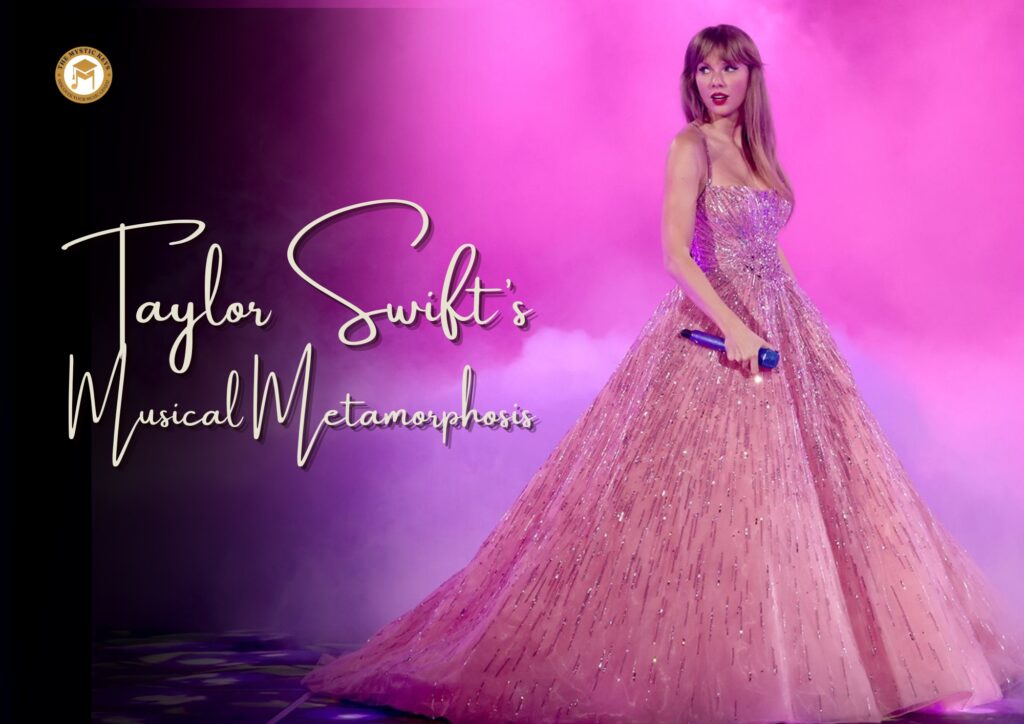Taylor Swift’s Musical Metamorphosis | Country Roots to Global Icon
In today’s music world, few artists have evolved as gracefully and lastingly as Taylor Swift. Taylor Swift’s Musical Metamorphosis—from a teenage country star to a global pop icon—is more than a genre shift. It’s a story of reinvention, resilience, and creative growth.
Each phase marked a turning point, allowing her to reach new audiences while staying rooted in honest storytelling. This evolution isn’t just musical—it’s deeply personal. Every album feels like a chapter, every song like a page from her life.
From writing heart-on-sleeve ballads to bold anthems of self-empowerment, she’s grown alongside her fans. Her style, sound, and voice have matured with each passing year. Whether in cowboy boots or glittering bodysuits, she commands the stage with authenticity. Taylor’s journey shows how change, when embraced with purpose, can become legacy.

Humble Beginnings | A Country Girl with a Guitar
Taylor Swift’s story starts far from the glitz of the Grammys or the spectacle of stadium tours. Born in Reading, Pennsylvania, Swift was drawn to music from an early age. Her admiration for country legends like Shania Twain and the Dixie Chicks sparked a passion for storytelling through song—an interest that would become her artistic foundation.
By the time she was 14, she had moved to Nashville and signed a deal with Big Machine Records, making her one of the youngest artists to break into the competitive world of country music. Her debut album, Taylor Swift (2006), featured simple but sincere storytelling, with tracks like “Tim McGraw” and “Our Song” capturing teenage emotion in ways few others had.
This phase of her career established more than just a genre preference—it introduced the world to a songwriter deeply attuned to the emotional textures of life. It also laid the groundwork for the lyrical prowess that would become a hallmark of her future work.

Laying the Groundwork for Change | Fearless and the Rise of a Star
While Taylor Swift initially emerged as a promising country talent, it was Fearless (2008) that truly launched her into national—and eventually international—stardom. With chart-topping tracks like “Love Story” and “You Belong with Me,” she skillfully fused country storytelling with infectious pop melodies, effectively blurring genre lines and capturing the hearts of a diverse audience.
This widespread success marked more than just a commercial milestone—it signaled a pivotal moment in Taylor Swift’s musical metamorphosis. No longer confined to the boundaries of country music, Swift was rapidly becoming a crossover sensation. Her Grammy win for Album of the Year at just 20 years old further solidified her standing as a rising cultural force.
Yet, even amid the acclaim, subtle signs of transformation were beginning to emerge. Her lyrics grew more introspective, her arrangements more ambitious, and her sonic palette more varied. These evolving choices quietly laid the groundwork for the bold artistic shifts that would define the next chapters of her journey.

The Bridge Between Worlds | Speak Now and Red
As her fame grew, so did her artistic confidence. With Speak Now (2010), Swift took full creative control, writing every song herself—an increasingly rare feat in the pop industry. The album maintained her country-pop blend but pushed toward more sophisticated arrangements and introspection, exemplified by songs like “Dear John” and “Enchanted.”
It was with Red (2012), however, that the bridge to a new world was firmly established. This album marked her first intentional step away from country, embracing pop and electronic influences on tracks like “I Knew You Were Trouble” and “We Are Never Ever Getting Back Together.” Yet, ballads like “All Too Well” reminded listeners that her songwriting soul remained intact.
Red was not just an experimental phase; it was a declaration of artistic autonomy. Swift was ready to embrace the complexity of love, loss, fame, and identity—all while reshaping her sound for a broader audience.

The Pop Pivot | 1989 and the Birth of a Global Icon
With 1989 (2014), Taylor Swift’s Musical Metamorphosis entered a bold new phase. For the first time, she fully embraced pop, leaving her country roots behind. While the move was risky, it proved to be a game-changer. Influenced by 1980s synth-pop, the album delivered glossy production, infectious hooks, and sharp, reflective lyrics.
In particular, “Blank Space” cleverly mocked media portrayals of her love life. Meanwhile, “Style” and “Out of the Woods” offered a cinematic, polished sound. In contrast, “Shake It Off” stood out as an energetic anthem of defiance and resilience. Together, these tracks showcased her confidence and ability to reinvent.
As a result, this was more than just a genre shift—it was a complete transformation. Swift wasn’t merely changing styles; she was expanding her artistic identity. Her image, sound, and audience evolved in sync. No longer transitioning between genres, she was now blurring and redefining them.
Moreover, her fashion, stage presence, and visual storytelling took on new sophistication. The 1989 era solidified her as a global pop powerhouse. Ultimately, it made one thing clear—Taylor Swift’s evolution was deliberate, fearless, and just getting started.

Reinvention Through Resistance | Reputation and the Power of Narrative
By 2017, Swift had become a lightning rod for public scrutiny, embroiled in feuds with other celebrities and a growing media obsession with her personal life. Rather than retreating, she responded with Reputation—an album steeped in dark synths, venomous lyrics, and unapologetic bravado.
“Look What You Made Me Do” was more than a comeback single; it was a mission statement. Swift was reclaiming her story on her own terms. The album fused elements of hip-hop, trap, and electro-pop with her signature lyrical depth, offering a complex portrait of a woman in the eye of the cultural storm.
This wasn’t a fall from grace—it was a rebirth in fire. And it proved that Swift could weather any storm and emerge more powerful than before.

Reclaiming Light | Lover and the Return to Color
After the sharp edges of Reputation, Swift pivoted once again, signaling another phase in Taylor Swift’s Musical Metamorphosis. With Lover (2019), she delivered a vibrant, romantic, and politically aware album that felt fresh and heartfelt. This record revealed a more open-hearted Swift, willing to delve into themes of enduring love, acceptance, and vulnerability.
For instance, songs like “Lover” and “The Archer” showcased her lyrical intimacy, drawing listeners closer to her personal reflections. Meanwhile, tracks such as “You Need to Calm Down” clearly signaled her outspoken support for LGBTQ+ rights and broader inclusivity. Simultaneously, during this era, Swift began a highly publicized battle to reclaim her master recordings—a bold move that would ultimately impact the entire music industry.
In many ways, Lover marked a nuanced return—not to her country beginnings, but to the sincere, earnest songwriting that first defined her, now enriched with maturity and deeper self-awareness. This phase beautifully bridged her past and present, reinforcing her ability to evolve while staying true to her core.

The Introspective Turn | Folklore and Evermore
The pandemic years brought yet another transformation. Swift surprised fans with two sister albums: Folklore and Evermore (2020). These records abandoned commercial pop for indie-folk and alternative stylings, crafted in collaboration with Aaron Dessner of The National and long-time producer Jack Antonoff.
Tracks like “Cardigan,” “Exile,” and “Champagne Problems” were moody, literary, and reflective. Rather than drawing from her personal experiences alone, Swift built fictional narratives, adopting characters and telling their stories with haunting beauty.
These albums revealed a different kind of power—quiet, introspective, and deeply artistic. And once again, Swift was not following trends—she was creating them.

Taking Back Control | Taylor’s Version and the Reclamation of Power
In 2019, Swift’s former label sold the master rights to her first six albums, sparking a public debate about artists’ rights. Swift’s response was bold and unprecedented: she would re-record and re-release each of her early albums as “Taylor’s Version.”
These re-recordings were not just commercial successes—they were acts of cultural defiance. They rekindled fan memories, introduced previously unheard “vault” songs, and inspired new appreciation for her songwriting legacy.
By reclaiming her past, Swift reshaped the future for herself—and possibly for generations of artists to come.

The Eras Tour | A Living Retrospective of an Artist in Bloom
And now, in the present day, Swift has embarked on The Eras Tour—a stunning, multi-act celebration of her musical journey. Each era is represented in full theatrical form, with intricate set design, dazzling costumes, and emotional performances.
The tour is not just a concert—it’s a live museum of her metamorphosis, showcasing the evolution of sound, style, and soul across nearly two decades. It has also become one of the most commercially successful tours in music history, reinforcing Swift’s place at the very peak of global stardom.

Conclusion | A Career Defined by Courage and Creativity
Taylor Swift’s evolution is not just about changing genres or experimenting with aesthetics—it’s a case study in courage, creativity, and control. Few artists have navigated fame with such intentionality, constantly adapting while staying true to their voice.
From country innocence to pop opulence, from indie introspection to industry rebellion, Swift’s journey has been one of continual reinvention—each step marked by deeper layers of authenticity and vision.
She is not merely a pop star, a songwriter, or a performer. Taylor Swift is a cultural architect—shaping not only music but the way we relate to artists, stories, and ourselves.
And as she continues to write new chapters, one thing remains clear: her metamorphosis is far from over.
Related Blogs
Lady Gaga, the musical alchemist, embodies a journey of resilience, artistic discovery, and profound cultural impact. Known for blending striking visuals with powerful music, she continually redefines pop and inspires millions worldwide.
Hip-hop has always been a genre that values storytelling. From the early days of rap battles to modern-day concept albums, the best artists have used their words to paint vivid pictures of life, struggle, and triumph.








